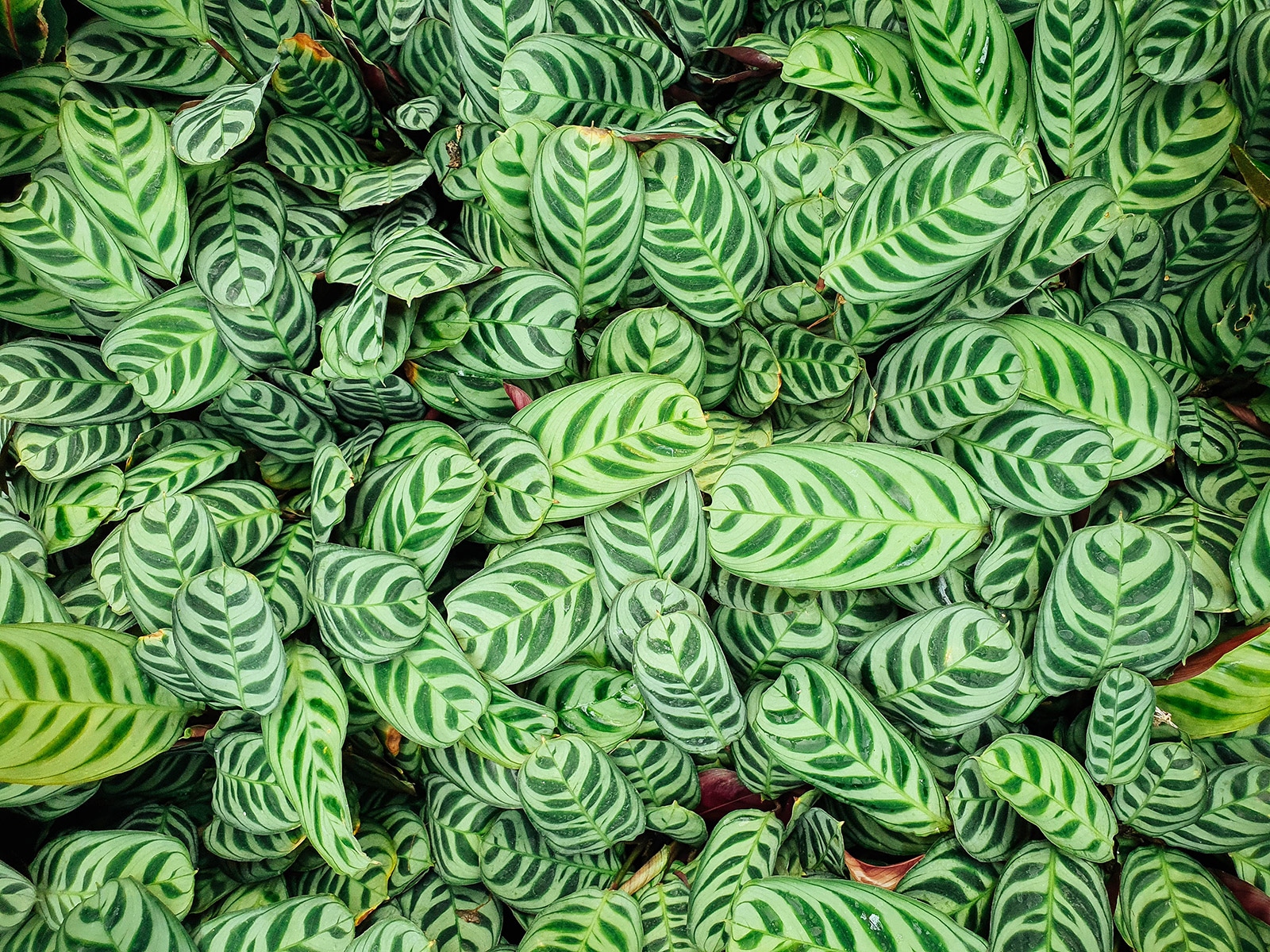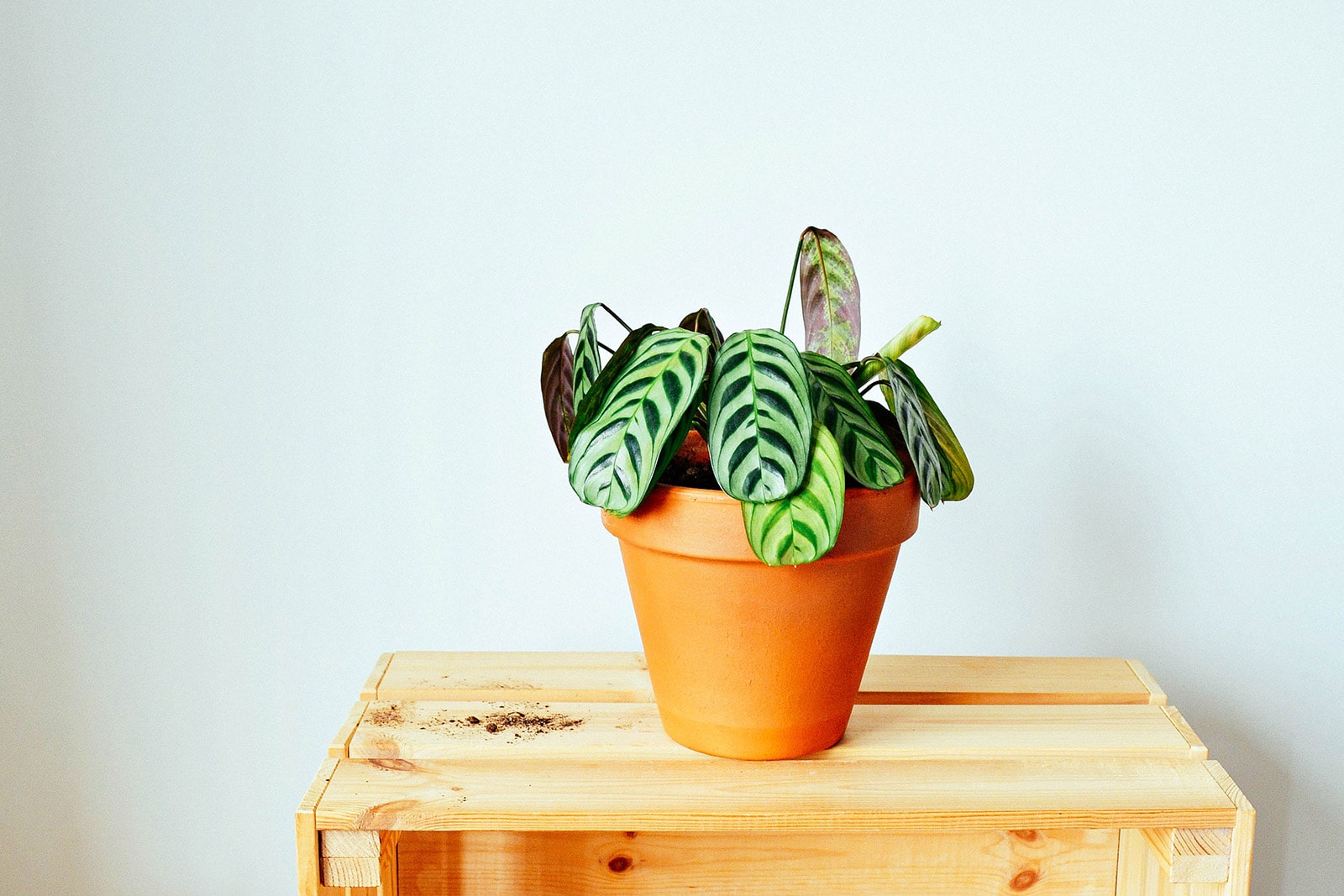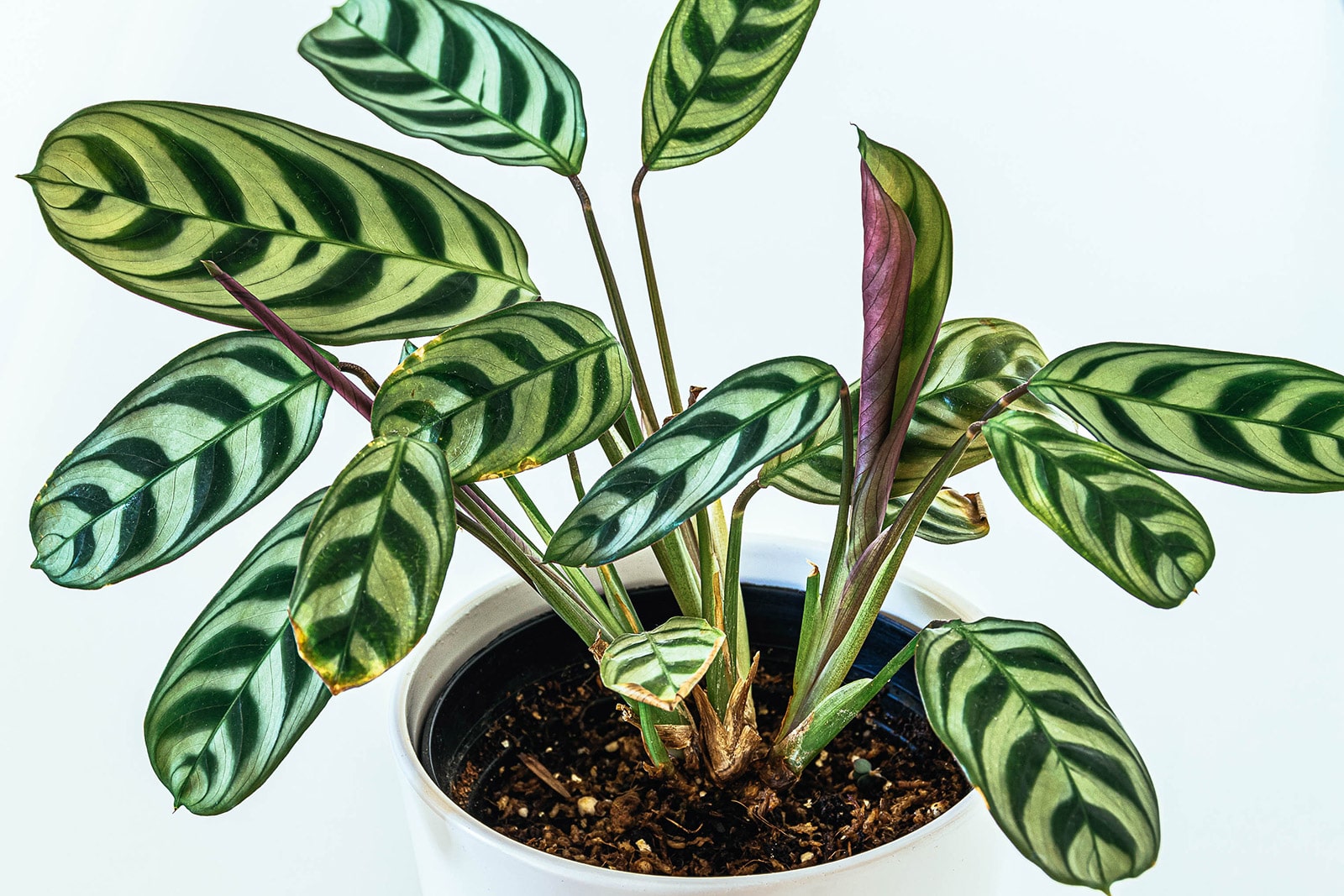Looking for a stunning houseplant that really catches the eye? The family Marantaceae (the arrowroots) has plenty to choose from, including today’s subject: the genus Ctenanthe. If you like flashy foliage, this species (which is also known as the never never plant) might just be perfect for you.
Let’s go into all the ins and outs of Ctenanthe care and the different beautiful varieties you may encounter in your local plant store!
| Common name(s) | Never never plant, fishbone prayer plant, Bamburanta |
| Scientific name | Ctenanthe |
| Family | Marantaceae |
| Height and spread | Up to 3 feet high and wide |
| Light | Bright indirect |
| Soil type | Rich but well-draining |
| Water | Keep lightly moist |
Disclosure: If you shop from my article or make a purchase through one of my links, I may receive commissions on some of the products I recommend.

About Ctenanthe
Natural habitat
The genus Ctenanthe, like most of the overarching family it belongs to, is naturally found in South America. Specifically, with some exceptions, most of the members of the genus occur in Brazil. The majority is found in the Atlantic rainforest, an extremely biodiverse area that’s home to many of our favorite houseplants (like Calathea makoyana, Tradescantia zebrina, and Begonia maculata). Some others prefer the Amazon rainforest.
The specific habitat varies: the Atlantic rainforest is home to a bunch of different types of forest, for example, and some Ctenanthes prefer being almost at sea level while others occur at much higher altitudes. What they all have in common is that they’re part of the undergrowth in forested areas, where temperatures and humidity tend to be high and light levels are relatively low.
Did you know?
Ctenanthe is considered one of the prayer plants (along with other popular houseplants like Goeppertia, Calathea, Maranta, and Stromanthe). This name is derived from the fact that its leaves move with the day/night cycle, folding upwards when it’s dark and resembling hands in prayer (a daily movement called nyctinasty).
The sometimes sudden movements can spook you if you’re not expecting them! Scientists have mostly figured out how it happens, but admit that they’re still really not sure why.
Description
There is a bit of variation within Ctenanthe when it comes to their color and patterns, but the basics pretty much stay the same across the genus. These plants are characterized by their bushy, clumping growth pattern. They don’t tend to grow all too tall (up to about 3 feet), but if left to their devices, they can become very wide. The leaves sprout from a central rhizome and are oval in shape.
All Ctenanthes flower, but none of them are grown as houseplants specifically for their blooms: It’s their bright, patterned and variegated foliage (resembling a fishbone) that makes them so attractive. This striking fishbone pattern is why Ctenanthe is sometimes called the fishbone prayer plant.
How do you pronounce Ctenanthe?
I admit, this one had me stumped at first! The proper pronunciation of Ctenanthe is ten-AN-thee or ten-ON-thee (both ways are correct). The “c” is silent here.
The name Ctenanthe is derived from the Greek word ktenos, meaning “comb,” and anthera, meaning “anther.”

Ctenanthe varieties
Although there are 15 species of Ctenanthe, not all of them are commonly grown as houseplants. The ones that are can be similar in looks, making it difficult to tell them apart sometimes. No matter: Their care requirements are the same.
The ones you’re most likely to come across in your local plant store or garden center are:
- Ctenanthe oppenheimiana (also incorrectly known as Calathea oppenheimiana): In its natural wild form, this one is characterized by its tall stems with oval, light green leaves featuring dark green striping and reddish undersides. ‘Tricolor’, a popular cultivar, has an added splash of pastel pink variegation.
- Ctenanthe lubbersiana (also incorrectly known as Calathea ‘Golden Mosaic’): This oval-leaved species is sold in a few slightly different colors and patterns. The most popular variety (‘Golden Mosaic’) has dark green leaves with splashes of a yellower, light green, but there’s also a form that has more extensive, silvery variegation (‘Variegata’).
- Ctenanthe setosa: In its wild form, this species is pretty similar to Ctenanthe oppenheimiana, though with narrower leaves. However, there are also a few cultivars out there, like ‘Silver Star’ (with silvery leaves, very narrow leaf veins, and purplish red undersides). ‘Silver Star’ is also known as Ctenanthe setosa ‘Grey Star.’
- Ctenanthe burle-marxii: Features thicker leaf striping than the others, making for a beautifully dramatic display. The most popular cultivar is ‘Amagris’, which is pretty similar in looks to its cousin Ctenanthe setosa ‘Silver Star’ but has rounder foliage.
Did you know?
Both Ctenanthe oppenheimiana and lubbersiana are sometimes referred to as never never plant or (giant) Bamburanta. That’s why I use their scientific names to avoid confusion! Common plant naming is often jumbled and not very helpful.
Where to buy

Caring for Ctenanthe
Light and temperature
Because Ctenanthe is naturally part of the forest undergrowth, it isn’t used to overly bright light. This isn’t a plant to keep in the dark—it needs a spot where it gets plenty of indirect light—but direct sun can be too harsh for it, especially without proper acclimation.
When it comes to temperature, you shouldn’t run into any issues in a normal house. Ctenanthes like things nice and toasty, preferring room temperature or above. If you feel comfortable in your home, then your plant is likely fine as well. Avoid letting temperatures drop below 55°F to prevent issues like leaf loss.
Water and humidity
This bit is where things go south with Ctenanthe for many houseplant enthusiasts. The species loves plenty of moisture, which isn’t surprising from a plant that hails from often soaking wet habitats like the Atlantic rainforest. However, it’s also easy to overdo it, with waterlogged soil leading to root rot and the beautiful foliage dying off.
I can’t tell you exactly how often to water your Ctenanthe, as this depends on things like the season, light, temperature, and air humidity. Soil is also a big factor, which I’ll discuss in the paragraph below. Watering on a schedule is not recommended, so learn to gauge your plant’s thirst level by poking a finger into the soil, picking up the planter to assess its weight, or using a moisture meter like this one.
The soil should be lightly moist (a bit more during the summer growing months than during winter), but by no means wet. Water again once the first inch or so has dried. Don’t wait too long; a Ctenanthe will show its thirst by dramatically curling its leaves. Your plant will perk back up after a good soak, but usually not without permanently losing a leaf or two.

As for air humidity, this is another very important factor that tends to cause trouble. Our homes can be very dry, especially in winter, which a tropical plant like this doesn’t appreciate at all.
The humidity level should ideally be 60 percent or up for a Ctenanthe, meaning you may have to run a humidifier to keep these guys happy. Dry air makes them particularly vulnerable to spider mites, which love their papery foliage. (This is the hygrometer I use indoors to measure humidity.)
Did you know?
The family Marantaceae, of which Ctenanthe is a part, is considered to be on the finicky side. Don’t beat yourself up if yours doesn’t thrive! Not all plants are suitable for all homes.
Soil and planting
Ctenanthe loves some moisture in its soil, but is also vulnerable to root rot as a result of waterlogging. This means that the ideal soil mixture for your never never plant should include both a water-retaining element (like coco coir, peat, or sphagnum moss) and an element that promotes drainage (like perlite, orchid bark, or pumice).
You can mix a handful of one of each of these soil additives to a normal houseplant potting soil. Always use a planter with a drainage hole in the bottom for your Ctenanthes, and avoid terracotta unless you’re very prone to overwatering. This material is porous and allows water to evaporate through its walls, meaning it can dry out too quickly.
Recommended products for Ctenanthe plant care:
- FoxFarm Ocean Forest Potting Soil
- Better-Gro Special Orchid Potting Mix
- Better-Gro Orchid Moss
- Perfect Plants Organic Perlite
- Nature’s Footprint Pumice Soil Amendment
- ThermoPro Digital Hygrometer
- Classy Casita Soil Moisture Meter

Fertilizing
A healthy Ctenanthe will absolutely appreciate a little extra boost. If your plant is growing well, you can use a diluted, balanced liquid houseplant fertilizer around once a month or so while watering.
Stop feeding your houseplants during winter or if they aren’t doing well to prevent damaging their roots.
Recommended fertilizers for Ctenanthe:
- Houseplant Resource Center Liquid Fertilizer for Houseplants
- Instant Biologics Instant Plant Food (Fizzing Nutrient Tablets)
- Maxsea All-Purpose Seaweed Plant Food
Pruning
The species doesn’t usually need pruning, aside from the removal of dead and unsightly leaves. This is part of normal houseplant maintenance; a healthy Ctenanthe will eventually get rid of its older leaves in favor of new, fresh ones. As long as foliage isn’t dying at an alarming rate, it’s nothing to worry about.
Dividing or repotting
Ctenanthe is a clustering plant that can reach an impressive horizontal spread. This makes it a prime candidate for division. If yours is becoming too large for its planter, but you don’t want to repot, just remove offshoots and pot them up separately. This way the mother plant can stay in its original home.
If, alternatively, you want her to reach her full potential (offshoots and all), you’ll likely have to repot once every one to two years. You’ll know it’s time when the soil starts drying out too quickly and roots begin to protrude from the planter’s drainage hole.
If you choose not to repot, do remember to give your Ctenanthe some fresh soil every other year or so.

Propagating Ctenanthe
Due to its growth pattern, Ctenanthe (just like its cousin, Calathea) is unfortunately not really a candidate for the easy method of stem propagation. It just doesn’t have stems, as the leaves sprout directly from the roots.
Luckily, as mentioned above, you can still multiply your plant if you’d like to do so. Division is the way to go. Although this usually involves uprooting the plant, it’s very easy:
- Take your Ctenanthe out of its planter and carefully shake excess soil off the roots.
- At this point, different clusters of plants may separate by themselves. You can also separate clusters yourself by pulling or vertically cutting them apart.
- Offshoots will usually have roots, meaning they can simply be potted up and will keep growing as usual. Offshoots without a root system can be rooted in water.

Common questions about Ctenanthe care
Is Ctenanthe toxic to cats and dogs?
Nope! These beauties are non-toxic and pet-safe, making them the perfect choice if your home contains furry friends or tiny humans.
Are Ctenanthe and Calathea the same?
Ctenanthe and Calathea are both known colloquially as prayer plants due to the way their leaves fold up at night. While the plants are closely related, Ctenanthe and Calathea are entirely different genera and references to Calathea oppenheimiana, Calathea ‘Grey Star’, and Calathea ‘Golden Mosaic’ are incorrect—all of these plant species fall under the genus Ctenanthe.
The mislabeling is common when buying plants, and it is absolutely confusing for the average houseplant shopper!
Why does my Ctenanthe have brown leaf tips?
One of the most common causes is this species’ relative sensitivity to tap water. It doesn’t always respond well to the presence of fluoride, chlorine/chloramine and various minerals, which can build up in the soil over time.
You don’t have to switch to special fancy water to avoid this issue, but it can be very helpful to regularly give the soil a good flush with distilled water.
Sources:
https://powo.science.kew.org/taxon/urn:lsid:ipni.org:names:30024856-2
https://patents.google.com/patent/USPP14641?oq=ctenanthe
Luna, N. K. M. D., Pessoa, E., & Alves, M. (2020). Synopsis of Marantaceae in the state of Pernambuco, Brazil. Rodriguésia, 71.
Pischtschan, E., & Claßen-Bockhoff, R. (2010). Anatomic insights into the thigmonastic style tissue in Marantaceae. Plant systematics and evolution, 286(1), 91-102.
















Thank you very much. I appreciate your attention to detail and to using reputable and informative sources! Now that I’ve figured out what my plant is, I can go and try to take care of it properly. Thanks again!
Hello,
I found your site (gardenbetty.com) from SERP and found it extremely awesome! I wanted to know if you accept paid content in the form of guest posts and give a do-follow link to our client’s site.
Kindly let me know the price per post (if you are interested to sell sponsored posts on your blog).
Also, we might be interested in placing in-content text links (link from an existing blog post) please do let me know the price per text link placement as well.
So tell me the prices, and we’ll get an agreement ☺
Have a nice day!
Regards,
Alina
Outreach Manager at Webs cordial